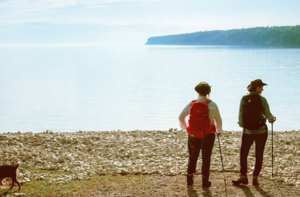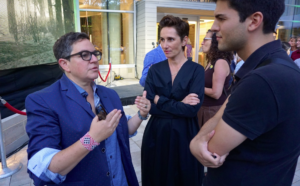
Surviving Memories: an interview with Elle Flanders (2012)
Elle: I was born in Montreal but moved to Israel when I was six. Defining moments remained unnoticed until I was old enough to understand the nuances. Everything came back in a flash for me when I moved back to Montreal; the rage, the passion, the outsiderness. It all came flooding in, putting pieces in place while displacing others. It seems like a cliché, something I hate talking about, for that reason and others.
When I was twelve we lived in Jerusalem, our third apartment in three years. Perhaps my parents were restless and uncertain. To us however, it just felt like constant flux. I had joined the scouts which in Israel is more of a youth movement. They teach you about the land, the flora and fauna, and while in retrospect I recognize the nationalist motivations, it taught me deep appreciation for nature and our markings upon it.
After a weekend trip, where we rappelled down water towers (pre-army training?) and hiked through beautiful mountains, we returned to Jerusalem at night. There was a blackout in the whole of the city that night. There were no buses or phones, so I walked home alone in the dark with my bright orange backpack. I passed my grandparent’s home in an upscale area of Jerusalem to our new apartment five minutes away. They were still living in London half the year and no one was home. A few steps past their house, a man ran from behind me, put his hand over my mouth and wrestled me to the ground. A couple of minutes later, a car came around the corner, the man got off me and ran away. I ran in front of the car to make it stop. I babbled and they took me home. I told my parents I had been “mugged.” A friend of my parent’s was at our apartment, a large gentle giant named Joe. The urban legend was that Joe worked for the Mossad, Israel’s notorious spy agency. He put me in his car and we drove to find my attacker, but to no avail. I returned home and soaked in a bath for two hours, scrubbing the filth that crawled now in my skin.
The next day we went to the police station to report the attack. My mother’s Hebrew was simple, adequate for grocery shopping, not police reports. A woman officer took me into a room, alone. She handed me a dictionary opened to a single page—the word for rape in Hebrew translated for me. She wanted to make sure I understood. I closed it, returned it to her and fidgeted. She asked me what he looked like. “Was he Arab?”
An unidentified man tried to rape me. I saw him on every bus I ever boarded, every corner I rounded thereafter. He looked like everyone: Jewish, Arab, blond and dark. Forever I spoke of it as a mugging. Until I came to Montreal that is, many years later, where there was language and safety in numbers. I was now simply one amongst hundreds of thousands of women in the same position. The policewoman’s question crystallized only years later when I began my work against the Occupation. Was he Arab?
When I returned to Montreal I was confused about almost everything. Freshly returned from a land in conflict that pretended it wasn’t, I searched instead for some certainties and the lesbian feminist separatist movement (LFS) seemed the most certain of all. I didn’t think it was a problem that I wasn’t (yet) a practicing lesbian, that would come I was sure—I just thought it was important to find an affinity group. The hardcore politics matched the edge that Israel had loaned me. I had marched out of my parents’ home that year and thought it was time to begin on my own, again. I couch-surfed at a friend’s place until she agreed I was too much fun or at least too indispensable for the extra $75 rent a month. I decided I was going to be a photographer, so I went to Concordia Fine Arts. The Simone de Beauvoir Institute at Concordia was the hotbed for all things lesbian and feminist. They had film screenings, talks, and more importantly pretty, radical, hot girls (I mean women). There was some overlap between some of us LFS in Fine Arts and the women at the SdBI. From there we branched out into the Montreal dyke night life and we would meet at L’Abyris, a bar next to a porn theatre (did we glue their locks that year? I can’t remember…). There was always one particular woman on the door who kept men from entering. She had short, gelled, jet black hair, a streak of crimson lipstick, and couldn’t have weighed more than 100 pounds. But her shoes had points on them that could kill roaches in corners and get a few guys in the crotch if they tried to muscle in. Ah, L’Abyris! That’s where we had film screenings too. A sheet, a projector and chick flicks.
In Montreal in the early 80s there was little room for men, gay or straight, in the lesbian movement. We were on zero tolerance. We marched for Take Back the Night in shirts my friend Lisa had designed and spray-painted that said “Femmes Sans Peur” with a fist in a woman’s symbol. And despite the fact that I still indeed had much fear, you could feel the surge of adrenalin just being in the heart of the pack on Rue St. Antoine. The snow was falling, my combat boots providing no warmth whatsoever, but we were invincible; the feminist revolution had come and there was nary a man in sight. We ended up in the basement of someone’s house—well actually they lived in the basement—and we all flowed in for a screening on a sheet. We saw some new films that one of our cohorts Leila had made. (She used to wear a Kafiyeh all the time; she was part Lebanese I think. I was just back from Israel having seeded the beginnings of a consciousness around Palestine where women were central to organizing the resistance… that was then). Leila had been reading Hélène Cixous as well as radical lesbian separatist Mary Daly who talked about an anthropology based on a foreground and background—men were in the foreground and women in the background and what was needed was a paradigm shift. Mary Daly wouldn’t let men into her advanced feminist classes in college. Leila had created two planes of vision in her film accordingly. There were no close-ups. Only women were filmed, only women’s voices were heard. It was shot in the landscape as buildings were still the domain of men. It was re-imagining the world albeit with only half the population.
I can’t remember the political divides to be honest. While I am sure they were at play, as the infamous wedge that was driven between feminists and lesbians is well-documented, but I think memory serves only to solidify, not to fragment the past. Hence in my memory we were all so deeply unified. Perhaps this is also a function of youth? You think you are all in sync, like when you first fall in love and you and your beloved are “the same.” The fissures only appear over time, and my stay in Montreal was only a couple of short years. We marched together, watched films together and agreed on a common enemy: patriarchy (often devolving into a dislike for “men” at the time, I admit). We were full of rage and passion, a toxic and heady mix for a young woman looking for the radical edge. There was a small group of us that took some cues from Ska and Punk too. There was a lesbian band called The Slits that created some space for us in that male-dominated arena. It was a subset of a subset of a… well you get it. (Secretly I still listened to my soft-70’s music that my sisters had exposed me to and some Israeli folk-pop that expressed angst and hope for “peace.”)
And then there was Aimée (instant love indeed). She was so sensual. An active member of the lesbian feminist separatist crew that I was attaching myself to in Montreal, 1984. We were watching Léa Poole’s La Femme De L’Hotel in a special women’s only screening. Aimée was a projectionist and we watched it in a Montreal dyke bar—she had somehow gotten a hold of the print. We knew Léa Poole was a lesbian, but were annoyed it didn’t play out in her film. While we debated her choice to be closeted, she was still our hero, our woman filmmaker, our lesbian, even if it was secret. A debate ensued. Didn’t lesbians have “a duty” to come out publicly and make lesbian work?! The room was split. I just stared at Aimée hoping she would notice me. I went with whatever she said. We walked with her bicycle debating the evening’s issues, I didn’t know what I was talking about. She invited me in. I didn’t know much about that either. I figured both out.
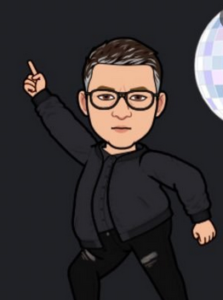
Mike: I’m guessing that you came to Toronto after your two years of separatist solidarity, but perhaps you ventured to some other city first? I can also imagine that Toronto must have felt like a very different place than Montreal, not quite so tightly knit, for instance, or radicalized in the same way. Was that disappointing? Or did you find your crew here easily and quickly, the ones who were going to change everything, one face at a time?
Elle: Dave Wall once called me a shark. He said if I stopped forward movement I would die. As I email you from my mobile phone, I think about this. It’s funny, I don’t think of myself as “on the move” but it seems I am.
I moved to Toronto to get even further away from my parents. They had disowned me (we reconciled when my father discovered he had lung cancer) and it seemed easier to be an outsider in an even more anonymous context. I regretted the move regularly. Montreal still holds my imagination. Isn’t that strange after all these years? I think I have a fondness for speaking in a tongue that is not my own. There is some kind of safety in it, perhaps an excuse for getting it wrong? Put me in Italy and I’ll speak Italian…
Toronto was a shock. It was a town compared to Montreal, located in the middle of nowhere. I wasn’t used to monoglots. There is something about having to think in more than one language that resonates in a culture; something to do with the seamless shifts between language and hence culture that creates invisible spaces wherein more than one meaning can reside. While I couldn’t articulate what was so very different about Toronto, I think it had something to do with that space for nuance or perhaps in my case, silent retreat. Radical separatism was not the order of the day in Toronto, and while perhaps it was the FLQ crisis that fueled the lesbian separatist moment in Montreal (spilling into the eighties), this was not part of the Toronto landscape that I entered. But there were so many other things to learn in Toronto once I got into a groove. I began my lessons in “the left” here. I met Marxists and gay men, I worked for DEC Films, I learnt a lengthy history of social movements and hating men was getting tedious.
I worked as a clerk at Glad Day Bookshop. True, the sexism was out of control; I was given a duster and told it was my job (as the only girl) to dust the shelves. But it had its own wonderful subversiveness. The Body Politic was in its last throes but its brilliant writers and activists were deeply present; books were being censored and porn was on the racks, behind the cash and at my fingertips. I joined the anti-censorship wars which buried my anti-porn antics, inviting something completely new.
I replaced radical separatism with just about every other radical thing I could find—it was a deeper and richer radical I admit. Worlds collided and blew apart for me. Films about struggles around the world passed through my fingertips as I diligently cleaned and repaired them for their next viewing, shipping them to the next destination.
Mike: DEC (Development Educational Centre) Films was a distributor of independently made, social justice films, offering views on liberation struggles from around the world. You clocked some serious time there, can you talk about that?
Elle: DEC was where it was at: Film, politics, engaged folks, all trying to create change through film. We were pretty optimistic that if our catalogue could make a dent in the education system, we would be seeing radical change within a period of say, 10 years—wink—even then I knew it was a battle we were unlikely to win. But a sliver of hope and a committed group of activists made our mission feel just and hence invincible much of the time. So there I was in the hub, diligently cleaning and repairing film, sometimes taking much longer than necessary so that I could sneak a peek at the plethora of frames containing explosive information for a newly forming activist. Brenda Longfellow had just completed her film Our Marilyn (1987) and I remember being completely mesmerized. I was supposed to be repairing it for its next classroom rental, but I couldn’t stop watching it. Richard Fung walked in on me, catching me in the act of scopophilia.
Helen Lee had just been hired at DEC and I looked to her for guidance. I followed her around, she seemed like a good bet. Down the hall from DEC was BTL—Between the Lines Books—talk about politicized folk. They were super-rad, super hard-core. People were coming and going from Nicaragua and Cuba, talking about “the revolution.” I was in heaven but still green ( was 21). I kept a pen and notebook with me at all times, keeping track of all the political jargon I needed to know to “fit in”: Equity Activism, Sandanistas, Hegemony and Empire. DEC’s mission was to build new audiences and to help promote change through innovative film and video as I remember it. Working with small social and activist groups allowed us to create core viewerships in hopes that it would then spread to larger ones, eventually bringing about political change. Queerly charged political work began to emerge in my time there, and people like Tom Waugh and Gay Bell were demanding its presence in the classroom. It was really the first (work) place I felt I could be myself: Queer and political. Even as a lesbo bartender or working at Glad Day Books previous to that, never gave me that sense of legitimacy. And while Glad Day introduced me to The Body Politic (newspaper) from a distance (we sold it), and to censorship issues from the sidelines (it was all about NAMBLA (North American Man Boy Love Association) back then), DEC gave me the queer world with the intersections of feminism, social movements, anti-racism work and revolution. This was my home and the people I met there are still the most influential in my life and work.
Sitting with canisters of films stacked several high, looping them back and forth, repairing, scoping, inhaling. Marilyn swims and swims. Will she get to the other side? Miles of footage stretching the political landscape… did it reach the other side?
Toronto 1996. Inside Out was in its sixth year. I was living in New York learning how to edit my first short 16 mm film with Rose Troche (of Go Fish fame). The “theatre” at the YMCA unsurprisingly smelt like a sweaty gym. My nine minute film was up next. At minute seven, the screen went black just as a fag in a dress was giving a dyke with a dildo a blow-job (it was a deeply political film about fascism, but somehow radical lesbian sex found its way into many of the nine minutes). I smelt smoke. My film was on fire in the projection booth! I stomped up the stairs in my combat boots. They clanked noisily on each metal stair. Heads turned. No one from the festival said a word as the audience was left in the dark for an eternity while they tried to fix the film. Eventually, most people left. My first screening. I vowed that were I to ever run a festival, I would never leave an audience hanging. Something I would live to regret when I took over the Inside Out Festival just six months later.
I moved back from New York after a stint at grad school and the Whitney Museum’s Independent Study Program. I had been working with Martha Rosler and Mary Kelly, not exactly lightweights. My partner at the time was also at grad school in NY but we had just heard from her sibling in Toronto that her mother had had a stroke. They paused on that news and after a moment, told us that in fact her father had a heart attack on the same night. Neither knew of the other’s condition, and they were being kept one floor apart in the hospital. We raced back to Toronto and it became clear that our time in NYC had come to an end; we were going to have to help her folks. We got “practical,” leaving grad school behind and looked for jobs. She signed up for law school and I found work with the Inside Out Festival. It all happened very quickly because Inside Out needed a coordinator within weeks (“coordinator” was the term remaindered from the last throes of the “collective”).
I was trained for a total of five days. There was an Apple SE computer that had belonged to the last coordinator, two desks, and some files. There were some program guides from the San Francisco Lesbian and Gay Film Festival that were intended to help me select films and come up with ideas. There was a volunteer programming committee to help realize the festival. It struck me that we needed a different structure if we were going to move forward.
The collective model wasn’t working; it was too informal for a festival that was itching to grow. We didn’t have the resources to expand so I felt we had to build some infrastructure first. While bigger isn’t always better, it was the 90s and BIG was definitely in the air—Queer Nation had recently been at the forefront of a new brand of Queer activism, so too The Lesbian Avengers. I had just returned from New York and had belonged to many of these groups—I confess I never ate fire, but I did have the same fire in my belly for making queers visible. The moniker Queer was actually taken on at that time by those of us who refused the mainstream, but wanted to create a space in society for ourselves in all our Queerness and weirdness. There was a sense that we could do and be anything, naive perhaps, but there was an electricity that was a combination of having made heady legal gains while maintaining a rebellious spirit. AIDS had ravaged our community, but it had also brought us together into a combined species that began to move through the city differently. This giant embodiment needed cultural containers and Inside Out was ripe to become one of them. And so I began “hiring” (you should forgive the expression because of our pay scale) some of the brightest and best queers I could think of to help me build the festival. Richard Fung was my first pick. I told him I had enough money (after removing a quarter of my salary and giving it to him) for a six-month contract for programming. We hashed out a vision together, and brought on some other brash and bold faces: Jane Farrow for some radical dyke rabble rousing and Shane Smith (who came as a volunteer fresh off the boat from Australia).
In one of my first forays into fund-raising I approached our lone corporate sponsor, Viacom. Now to back-up, how did Viacom, a huge US media corporation, come to sponsor a small queer film festival you may ask? Well it actually has to do with Free Trade it seems. Huh? When the Canadian Government allowed US corporations into Canada, the single condition was that they had to contribute in some way to Canadian society. This could be done through cultural donations. And so for the price of pennies for these corporations, they could set up shop in Canada if they “gave back.” Viacom chose a handful of festivals and invested in us. But even then, a Gay and Lesbian festival was quite risky. There were no banks or beer companies lining up to hand us sponsorships back then. So what gave?
I was ushered into a meeting with Viacom. I wanted to see if I could get a larger donation and thought that my growth plan might be of interest to them. But when I met with the top Viacom exec, she made it clear that they weren’t very happy with us and not because of our politics. I don’t think they knew what we were up to on the programming side. But they weren’t happy with our lack of growth, our lack of presence in the city (by their standards). Viacom felt we weren’t such a great investment and our $5,000 was on the chopping block (uh-oh, Richard Fung’s whole salary!). In our meeting I told the exec that I was new and committed to growth and described my plan to start building the infrastructure (and whatever other fancy two-stepping I could do to save that grant). She seemed convinced and took a shining to me. She relaxed and began to chit chat with me—she told me she was a Red Tory and supported Gay rights—I didn’t know what that meant, but nodded in acceptance. Just before I left her office, she said “I’m going to pass a tip on to you, I can’t tell you why. Go and speak with the head of Famous Players cinemas, his name is John Bailey and tell him I sent you.” Famous Players? I had mentioned we were looking for a new venue, but this seemed preposterous. But at her recommendation, I called the number she gave me, spoke with Mr. Bailey’s secretary and made an appointment for the next week.
I have to digress here for a moment and explain that I was a crew-cut dyke wearing T-Shirts with slogans like: We’re Here We’re Queer Get Used to It; Silence=Death; I Hate Straights, well, you get the idea. Why would I wear these shirts to meetings large and small? It boiled down to the belief that was circulating in the political movements of the time—that we could penetrate (pun intended) the seats of power, that if we could be visible in all our radicality, if we could be in their face and NOT MOVE, NOT RETREAT, and simply demand our equal space, we could achieve some semblance of rights and equality. It wasn’t—at least so I tell myself now—about becoming part of the mainstream, it was about having them make space for us in our difference. Naive again, perhaps, but it seemed revolutionary and necessary. Though I confess I did leave the t-shirts at home for my first meeting with Mr. Bailey at Famous Players. But just for the record I didn’t do straight drag either!
The elevator opened and I was met by Nancy, Mr. Bailey’s secretary. I was asked to wait, he was still in a meeting. I fidgeted. I was at last ushered into his office, a lush modern affair, replete with a white leather couch. At the end of a very long space, a white-haired man was bent over his desk. He looked up and asked me to take a seat on the white leather couch. I sat and looked around at the art while I waited. He came over, shook my hand and as an ice-breaker I thought I would talk about something I knew: “Nice painting,” I said, gesturing at the enormous canvas hanging over the couch. “Thank you,” he said softly, “my partner did it, he’s a painter.” A-ha! That was it! The head of Famous Players was a queer! It was all coming together. I breathed a sigh of relief because I wouldn’t have to find a way to both ask for cinemas for our festival and negotiate the awkwardness (I assumed would be his) of queers lining up outside his cinemas.
And so it began, a marriage between John Bailey and Inside Out that brought the festival out of the shadows and into the blazing lights of mainstream cinemas. For those who are critical of a queer festival becoming “mainstream,” I dare anyone to find the words to describe what it might have been like to see a marquee lit-up in Yorkville, a posh, conservative neighbourhood in Toronto, with the words “Inside Out, the Lesbian and Gay Film and Video Festival” at that historical moment and call it mainstream. To have hoards of queers lined-up along a (straight) street, arm in arm, kissing, hanging, and simply being very visibly queer. We weren’t there for the shopping, we were there because someone brave enough took a stand and said we had the right to be there, to be visible and to claim some space in his theatres. Thank you John.
As for content, that’s a whole other story. Our programming was similar to past festivals, although with the move to new cinemas there was definitely anxiety about what we could and couldn’t show. I refused any restrictions and held early discussions with John Greyson. “Would there be pornography?” he asked me. I thought for a moment and said: “Is it possible to screen queer films without dealing with sexuality?!” He laughed and said, “Well as long as it has ‘artistic merit’!” He was referring to the defense made in the 1993 trial of Eli Langer, a Toronto-based gay artist charged under the obscenity act for his paintings of adolescents. Langer won. I was trying to imagine how films like Peter Fucking Wayne Fucking Peter (1994) would fly in Famous Players and what exactly the reaction to that marquee might be, but we would cross that bridge when we came to it. To be truthful, I was more concerned about finding the right programming balance between new audiences and old. There was a tidal wave of queer cinema coming that was more mainstream than ever—films like Bound (1996) and Fire (1996) were on the circuit that year, countered by indie classics like Cheryl Dunye’s Watermelon Woman (1996). The writing was on the wall, Queer was changing rapidly, we were on the cusp of gaystream. I had a motto that year, or perhaps more of a mantra: “Give them what they think they want, and teach them about what they don’t yet know that they want.” This was in reference to our new audiences who weren’t necessarily fans of the more experimental tenor of the festival. The festival was inevitably going to change, but we were adamant about keeping our programming true to its roots of experimentation, radicality and alternatives while tossing in fluff and seeing some fur fly. I believe we were able to find that balance under Richard Fung’s wise guidance, Jane Farrow after that, and Shane Smith in my last years.
I take full responsibility for the downfall of queer at this point. I think the subtlety of “Let’s screen queer alterna-culture in the mainstream” got lost… not so shockingly. Back then I was thinking I would radicalize the straight movie-goer only to be overthrown and subjugated by the crush of gaystream. It was unstoppable as neoliberalism took hold of so many of our movements and shook them by the neck until we went limp. Sometimes the moments of failure that are so visible in something I am so passionately involved in overshadow the bigger picture for me. Much like Israel-Palestine, I hold these complexities personally, my conscience follows from there. This might be named grandiosity but more likely it’s occasional pessimism and disappointment that I wasn’t able to be more effective in my own small way. I think I’ve mentioned before that I go by the moniker of “pessoptomist?” I took this from the title of a satirical novel from 1974, The Secret Life of Saeed the Pessoptimist written by an Arab-Israeli writer Emile Habiby, who had served in the Knesset for nineteen years. Witnessing the conflict and the Occupation for this long has helped shape my worldview. I hope for something better but don’t believe in humanity’s ability (collectively) to do so.
And so it goes too for the queer world I have inhabited and the films that have helped create that world. The wonders that have run over my corneas for the past twenty years have led me to believe in something better. Sadly, those images were too often replaced with others that wrote over the alternative with hyper-saturated films; eye candy we all wanted a taste of. Escapism was tantalizing in a just-post-AIDS era, like Hollywood as an antidote to the Holocaust perhaps. In order to mourn, we needed to get past the pervasive melancholy. Neoliberalism presented a shiny new alternative to what kind of lives were “possible.” In these circumstances perhaps it was gullible to think we could embrace both worlds and not be devoured.
These days I retreat with Mel Brooks who reminds me that through vicious satire we can have everything and nothing. I’m not sure what that means but I have had this perverse desire to re-enact Springtime for Hitler as a response to the assaults and accusations of anti-semitism, self-hating Jew, traitor, etc. in the face of my activism.
But I digress.
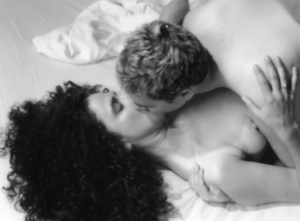
My first film Surviving Memory (9 minutes 1996) was a film about the Jewish other, the queer Jew who represented all things “not kosher” and the world of activism. It traced my engagement with anti-fascist work in the heyday of Ernst Zündel and other Holocaust deniers, to “queerness” (long before that was the only acceptable term), as a boy (named Ben pre Benny) goes down on my very large cock. The next film Once (12 minutes, 2001) was about my interest and misgivings about identity. Framed through a series of “disturbed” characters wanting to learn Yiddish (considered almost a dead language), the film takes Paul Celan’s poem Once as a starting point to discuss the impossibility of language (he committed suicide) and a renewed search for “home.” Each character is fatally flawed and so too is their search for home through language.
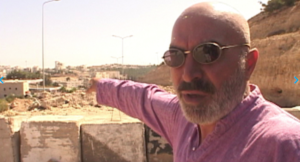
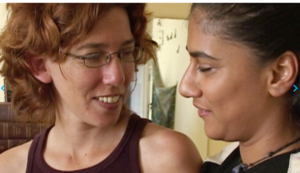
Finally I guess is Zero Degrees of Separation (90 minutes, 2005). That seems like a longer conversation. But let’s just say that it cast me so far outside of all my communities that I wonder if part of my QuAIA (Queers United Against Israeli Apartheid) activity is a way of trying to re-enter the queer community on my terms (and hence fail and fail again). The same could be said for my attempts to reconnect with the Jewish community. It seems I am always making work about being an impossible subject, an outsider, which then becomes a self-fulfilling prophecy. I think this might be where the pessoptomism rears its head again.
I want to challenge the status quo with difficult subjects, despite the likelihood that it will be rejected. Zero Degrees was an attempt to take queers back into the world of politics, of things that matter, and not dwell on the navel gazing “politics” that replaced everything else. The film was declared many times over “not queer enough” to which I always asked: what makes for a queer film? What is queer enough? At the NY Gay and Lesbian Film Festival a young woman said she wanted her money back as the film wasn’t really a queer film. I asked her what constituted a queer film? She paused and said: there wasn’t any kissing! I countered defensively (and of course with some sense of irony) that indeed there was one kiss. It clearly wasn’t enough. Of course one could argue that her difficulties lay with the subject of Palestine (she was clearly Jewish), but interestingly she located her discomfort in the film not meeting her queer expectations. This has been one of the reasons cited for it not having screened in many a queer film fest. And while it did a large festival circuit, it got slotted into some of the strangest programs and with a great deal of reaction most of the time. It seemed to upset Jews and queers alike. Interestingly I just screened it again in Pittsburgh this past week (it’s been a while) and two very young, lovely Israeli fags were there. They loved it. Perhaps I should take this as sign about all things coming into their time?
One of the major battles we fought these past couple of years at QuAIA was trying to make the queer community understand how and why Palestinian liberation is also a queer issue. This also leads to the larger issue of what is/was/should the Gay Pride parade be? Our claim was that Pride has and should remain a political entity, whether we are talking about global rights for queers or liberation struggles elsewhere. Queer rights are not secure until all people’s rights are granted. There can’t be freedom of gender and sexuality without freedom from daily violence and the right to love who you choose and live where you choose. I think we did a fairly good job of putting politics back on the agenda of Pride, which is surely the gateway for most to a space for queer identification.
Mike: For many years you have taken up the distinctly unpopular cause of a Palestinian homeland. Even for relatively clear-headed citizens, the ongoing oppression of the Palestinians seems to be normal, ordinary, even necessary. and all those who stand up for them, like yourself, are of course anti-semitic extremists preaching the end of Israel. Can you talk about your journey of solidarity, and some of the different expressions you have made along the way. including, at the very least, an extended photo project about women, a feature length doc, and most recently a six-screen meditation on displacement and occupied land?
Elle: I want to start with your first sentence about me taking up the cause of a Palestinian homeland. Hmm, I’m not sure that is what I am doing. I think I am insisting on justice for Palestinians, but I don’t always like to be specific about what that justice is, as it is not for me to determine. I’m not just trying to be “politically correct,” but rather I think big ideas of nationalism in any direction are frightening. I’ve seen the aspirations of what many nationalisms have wrought and I am not so sure I am fond of the results. It may be hair splitting, but I can work for justice and all that surrounds it, but I start to squirm when it gets closer to declaring how that should look. It could also be that Palestinian justice taken to its logical conclusion up-ends my parents and grandparents dreams, and while it may be correct, letting go of it is a greater psychological process than most are willing to be honest about. I often wonder why those involved in Palestinian rights aren’t more active here for aboriginal rights. This was something Amira Haas (left-wing Israeli journalist and writer) talked about at her last lecture here in Toronto. The parallels are so painfully obvious and she asked the audience that very same question. It’s not a directive to anyone in particular, but I do think the question needs to be asked.
You have to be so brutally honest with these issues and not just mouth the words because it is so very complicated. Especially for those of us who have a lot to lose on all fronts: family, community, dreams and hopes, smells and tastes that were all part of my adopted world from the time I was six. I have taken my partner Tamira to Palestine and Israel several times now and while she has learned the landscape, it is not what shapes her vision. We have often talked about what our landscapes mean to us—hers is attached to a childhood in Lake of the Woods, hence Canadian Shield, pine forests and lakes. My landscape has always been brown rocky rolling hills, olive trees, mourning doves, fuchsia bougainvillea. It’s partly why I find it so difficult to make films in Canada. I know that should change, but other landscapes make more sense to me. I think I have digressed here quite a bit but I am trying to give voice to something that many in the movement do not, which is an emotional attachment that is part of the equation for many of us. In facing that, it is harder but more passionate, more urgent and more honest, when working for a cause.
When I was seventeen, and stop reading if you’ve heard this before, I knew nothing about the Intifada, Palestinian rights, issues or struggles. I knew we lived amongst Arabs who weren’t always happy with us and I’d accepted the yarn that we in Israel were surrounded by Arab nations who wanted us to disappear, for Israel to be wiped off the map and the Jews thrown into the sea. And all because Arabs and Jews were historically enemies. I didn’t have a window into the roots of the conflict, I knew zero about dispossession. It’s hard to believe that one could be so ignorant, but these narratives are woven through you from the time you are young, I suppose much like the way Canadian history has been taught for much of our lives. I remember being at the Hebrew University at the time and I had met my first lesbians. I was taken by how they could be so boldly different and yet aware too of the whispering and ostracizing. I wanted to be their friend, to connect around deep seated alienation. It was my first “political” moment. They weren’t very political, in fact, but their act of defiance fuelled my hunger to know more about “outsiders,” more about the world I really lived in.
I had heard about Peace Now, an Israeli organization that was active against the settlements, marched for peace and was against with the Israeli government for the “unnecessary war.” This was new, I had been taught all wars in Israel were about survival. So I began asking questions. My grandparents were friends with one of the main organizers of Peace Now. It wasn’t something we ever discussed but I gravitated towards this woman and finally got the courage to ask her what was happening. She told me about the territories, the illegal settlement building, the offensive wars, and the injustice to Palestinians. My head exploded, my worldview was upended. But somehow I knew it all to be true already, it just finally clicked, it was an a-ha moment. We went to the West Bank together where she introduced me to women working in the Intifada, creating alternative schools while under curfew, working alongside men protesting the Occupation, and women whose daughters had been arrested by the IDF (Israeli Defence Forces) for publically protesting their conditions. I met a mother whose daughter was in jail. She was fifteen. She showed me a photo of her daughter. I photographed her portrait. I documented the bullets and shells that came through the windows and doors, I fingered and photographed the unfamiliar Palestinian household objects—mirrors surrounded by embroidery, birds in cages (the irony still doesn’t escape me), black velvet images of Jerusalem’s Dome of The Rock. I photographed it all to remember and learn all that had escaped my view for much of my life.
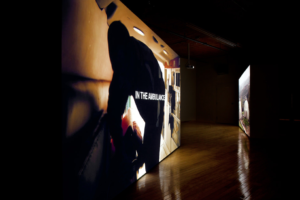
Over the years I feel I am still documenting, marking places that at once are so familiar and also deeply unknown to me. When we embarked on Road Movie (a six-screen installation with Tamira Sawatzky, 2011), we photographed and filmed the apartheid roads, some of which I had travelled many times, but never knew were segregated. Sometimes the process of making work is akin to connecting with something deeply familiar yet altogether unknown—creating a cognitive dissonance. Or more accurately, it creates a cognitive disequilibrium (cognitive dissonance is really about persuading yourself that something other than what you know is true. Here I am trying to get at the unsettling quality of having what you think you know upended). What Isn’t There (photo installation project with Tamira Sawatzky, 2011) documents Palestinian villages that no longer exist and is very much about this too: How perception is shaped by our everyday discourse and what we therefore see and don’t see. I walked through (abandoned, exiled) Palestinian villages regularly without knowing it, so I went back to walk there again newly informed. I photograph to remind myself and others that while we think we are looking at “nothing,” we are in fact looking at the unfolding of a history of dispossession. Looking means looking again.
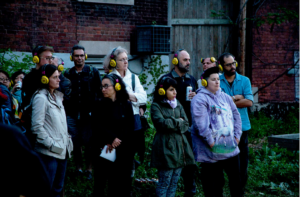
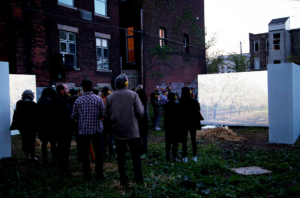

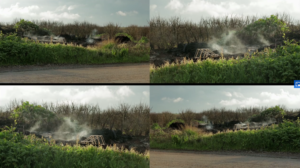
If I’d stayed in Israel to make this work would I feel less alienated? When I started, there was so little of this discourse here in the West. Even today I am more comfortable talking to Israelis about my work than North Americans. It is a much harder climb here because you are dealing with a Jewish community’s refusal to know, combined with a deep-rooted ignorance about what is happening. Israel is everything from an insurance policy for a post-holocaust traumatized community to a beacon of hope and democracy in an otherwise savage (Arab) world of dictatorship and corruption. Some Israelis at least know much of that is untrue as many experience their government as deeply corrupt and unjust (although more and more they have taken up the narrative of Arab as sworn enemy). But I am neither Israeli nor from here. The rejection is harsh and has been further elaborated by a queer community that feels my actions with QuAIA (Queers United Against Israeli Apartheid) have created an irreparable rift in the queer community.
So many queers feel the need to tell me that “they don’t take sides,” as a way to perhaps avoid this mess and/or not appear anti-Semitic. Let’s talk about that. Sometimes one can feel an anti-Semitic tinge to some of the activism, especially in these days of economic upheaval. Queer festivals talk about their fear of adopting a boycott because of the “Jewish money” that will fly out of their hands if they do so. If you press them about what money they are speaking of, it doesn’t seem to exist in any real form. It is the imaginary threat which determines their refusal. If you remember, this also happened with Gay Pride in Toronto, where it was said that QuAIA’s participation would result in lost sponsorships. Not only did that never happen, but the board and media kept repeating it as if it had. In fact sponsorship increased that year (only Moses Znaimer pulled his contra sponsorship for his FM radio station’s advertising). I don’t need to dwell here, but I do need to voice it, because it is as real as the Jewish and Israeli racism towards all things “Arab.”
Sometimes one must consider the end of Israel when doing work like this. Arguments for a bi-national state are for many the end of Israel, so it must be dealt with in some way, but perhaps not just in this email. We must have a place to voice our fears, our romantic attachments, our experiences, and our landscapes, be they constructed or otherwise and the complications of any nationalism. I think this is where I started.
It was interesting however being interviewed about Road Movie by RM Vaughn who went to great pains to tell me how he is “neutral” on the issue, that taking sides produces a no-win situation. I wonder how it would go over if the same rhetoric was used as it relates to the oppression of people of colour: “I don’t take sides in America’s racial issues, its lose-lose if you do.” Or, “While I’m sympathetic to the plight of Blacks in the US, there are two sides to this issue and we have to consider both.”
Isn’t injustice simply injustice no matter how you slice it? I do think there is a fundamental ignorance and racism at work here in relation to the Middle East. I have been reading a book on Orientalism that plots out its major critics, not just Said, but others who were early thinkers about this particular form of colonial fallout, and I am not sure how much this has been absorbed into our postmodern imagination despite the lip service we pay it. We have been able to digest Fanon, Bell Hooks, Stuart Hall, Trinh T. Minh-ha, but when it comes to Said, it seems it is often only in word, not deed. I suppose it is easier to understand colonial and post-colonial discourse when it is white versus black, not Arab versus Jew. I suppose too, and it is another important detail that often gets omitted, that while Israel may be an ongoing colonial enterprise, the mass influx of Jews after WW II were starving refugees, and the oft repeated national story is that Israel was born in that historical moment. That’s why I use the image of refugee arrivals off a boat at the opening of Zero Degrees because this is also part of the complexity. It does not excuse the situation, and in fact Palestinians will say themselves that one of the reasons they find the Occupation so hard to understand is because those who occupy them had been them just decades before. But it doesn’t make it go away, it doesn’t make it any less brutal or real. And at the end of the day, that is what must be dealt with. So perhaps the folks who ultimately confuse me in their timidity or who express the need for “evenhandedness” simply don’t see anything. As I mentioned earlier, for many, Israel is an imaginary space that emerged from the ashes of the greatest evil the modern world had witnessed, hence it cannot be wrong, bad or unjust.
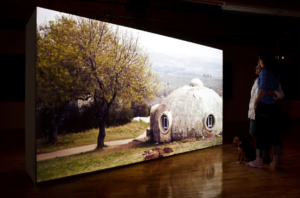
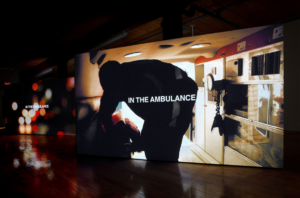
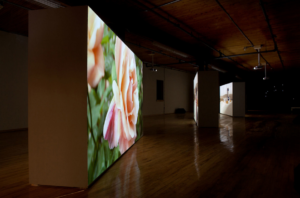
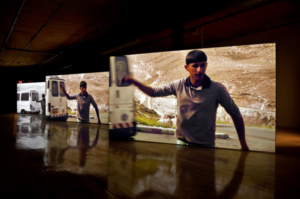
Mike: I wonder if you could spare a few words about your brainy architect partner Tamira Sawatzky? How did you meet up exactly? And why did you decide to get married? You are not only romantic partners but have made a bevy of movies and installations together. Can you talk a little about the desire for work, and the work of desire?
Elle: Tamira and I work hand in glove. We have different strengths. I am a work-shopper… I want the work out there right away. I want feedback, engagement, trouble. Tamira winces every time. She wants to keep it close until it is done. I am an extrovert. She is much quieter, much more shy. But I rely on her for structure—on all levels. Foundation. She takes us from block to block while I fly and dream. I dream big. Then go at it like a dog with a bone. I go into the psychology and philosophy of the everyday, she works through concrete details. When we have dinner together, which is almost every night, I’ll chew over problems. Sometimes I notice that she is staring over my shoulder, so I stop and ask her what she is thinking about. “The last frame that we were working on two nights ago.” Architects make great editors.
I feel like I am avoiding your question.
I am reading William Dalrymple’s Nine Lives: In Search of the Sacred in Modern India. He meets a Jain nun who seems inconsolable. She tells him her life story which consists mostly of having been raised in an affluent Indian family and deciding at fourteen that she wanted to become a Jain. She is thirty eight at the time of the telling and staying in the ancient pilgrimage town of Sravanabelagola. After the death of her best friend, also a Jain whom she travels with for twenty-four years, she decides to begin a ritual fast to death or “Sallekhana.” As I am sure you know, in Buddhism, craving is akin to desire, and is understood to be a kind of suffering. This nun could not overcome the death of her friend and so chose to end this life in order to move on to the next one. She could not overcome what the Jain’s understood as a barrier, her manqué, her missing part.
Desire always connotes an absence. It is not always a desire for the object at hand but for what one doesn’t have. It creates a movement forward, a drive that is never satisfied. It repeats itself. I suppose some people are able to tap into this within themselves, but for me it works best in relationship. My solo work often produces a repetitive absence that gets boring after awhile. I guess I understand desire as a dialectic which needs the other to create. Tamira is my other—she is both me and not and hence the missing part that allows me to create. She allows for the movement that I call living. I hope I do the same for her. My guess is that what the market allowed for in terms of architectural vision was somewhat stifling for her. I think she always wanted a more complex practice and that I was simply a vehicle towards that.
I’d like to add, if I may, as I never answered the part about meeting-up and getting married. It’s a funny story but anyone who knows me wouldn’t be surprised. We met at my house for dinner. I was cooking for friends I had lost touch with when they called me to cancel having double booked. As one might imagine, cancelling on me is not an easy task; I suggested they bring their double-booked friend along. Let’s just say she didn’t take a shining to me that evening. I was morose and difficult, and I talked about architecture as if I knew something. We argued about Liebeskind (although we disagree on the details…it wasn’t “Liebeskind in general” but I was talking about the Jewish Museum in Berlin, not the ROM addition). However, architectural conjecture was the last straw for her. She confesses now that despite how irritating she found me, there was something compelling as well. She contacted me some time later and I grew less irritating.
The marriage part came a little more whimsically than our first meeting. Everyone assumes I asked Tamira, but as I think might be clear from all of the above, marriage was not an agenda I subscribed to. In fact one might say I was even quite vocal about how this was not what I thought was the best use of our queer activist time and money. But picture this: You’re in Tulum, Mexico, you’re doing yoga and breathing for the first time in about ten years, you’re having incredible sex with a brainy gorgeous woman who turns to you in the back of a taxi and says: “What do you think about getting married?” Indeed. Let’s just say contradictions are the force of life and art.
